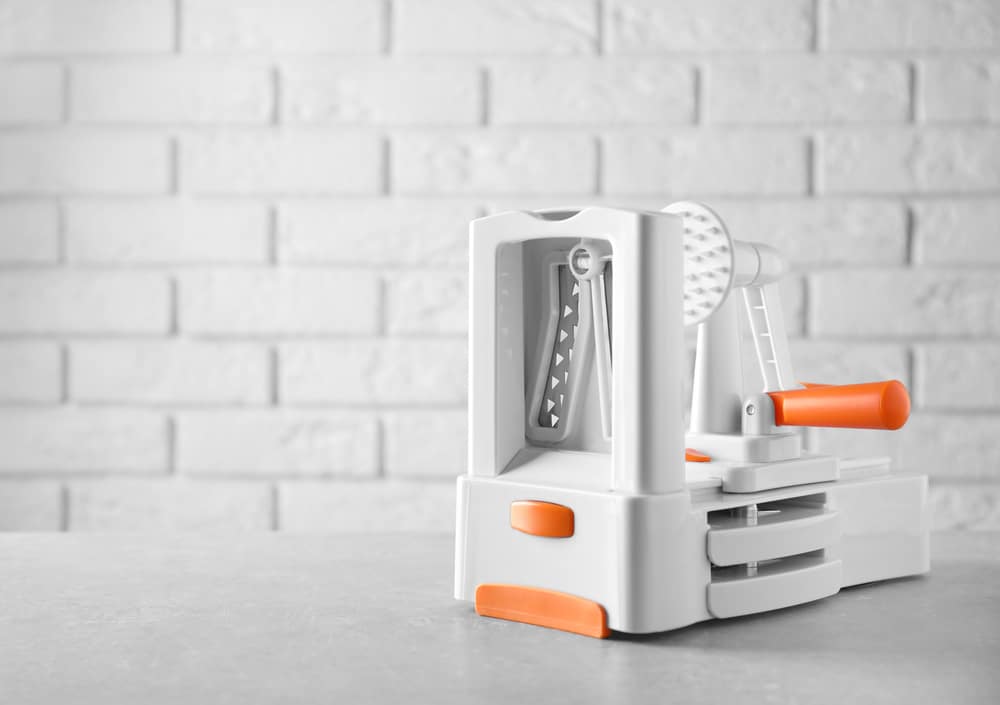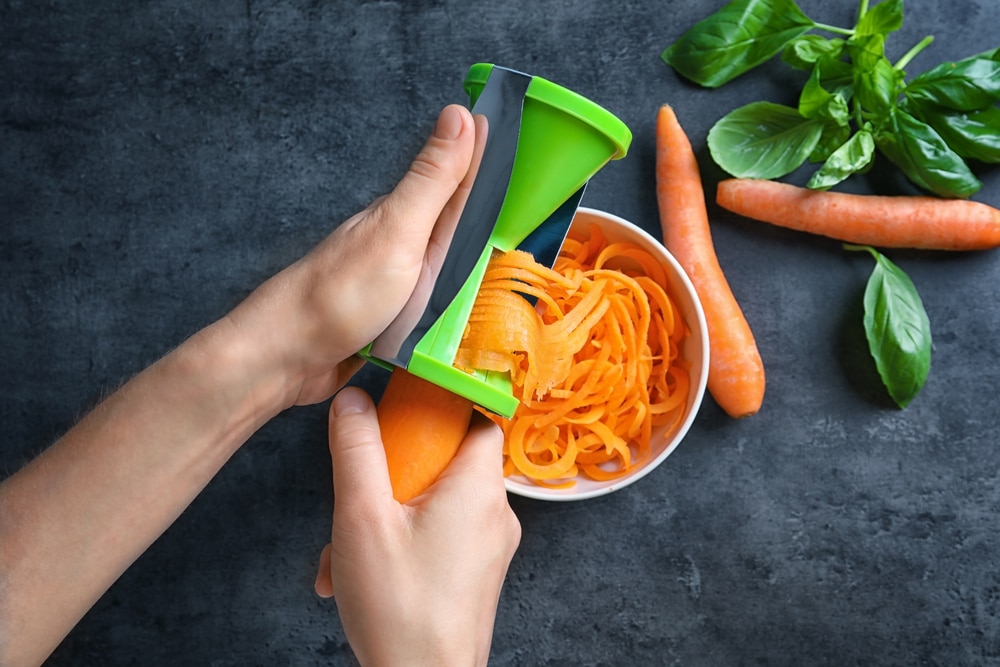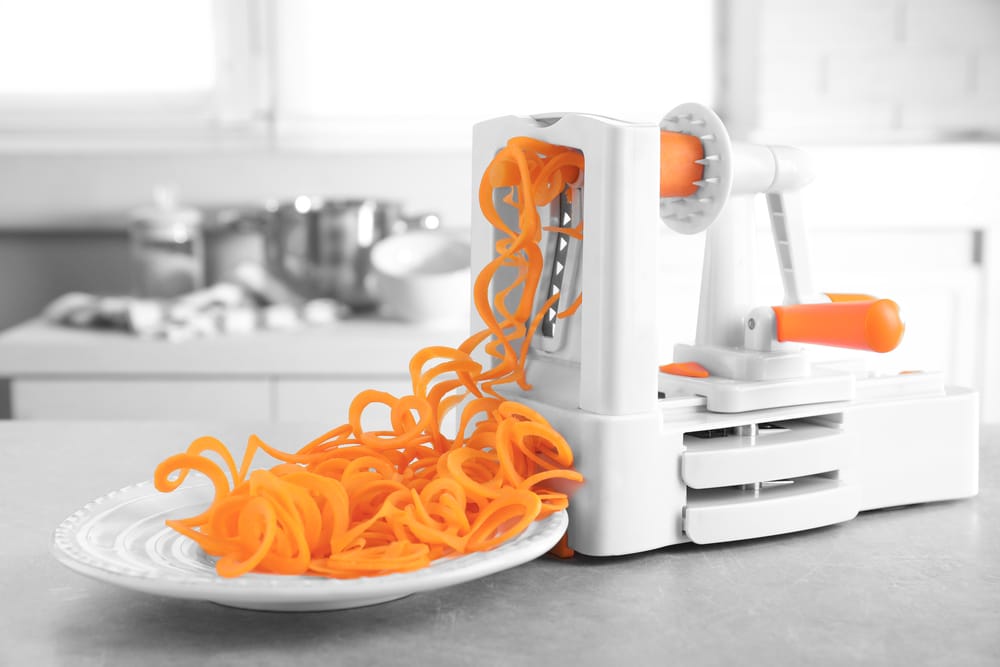Are you wondering what the best way to cut fruits and vegetables is?
Well, a spiralizer is a kitchen tool that can assist you in slicing fruits and vegetables for creating salads and many other vegetarian meals. It cuts fresh vegetables into noodles and other shapes, making your dishes look more attractive. For instance, you can use spiralized vegetables like courgettes or carrots to prepare various salads and stir-fries. You can also slice any root vegetables to make pickled onions or other healthy recipes.
Since spiralizers have varying designs, they operate differently. They also have sharp blades, so you should handle them carefully to minimize the risk of any injuries.
This post will show you how to use a spiralizer to cut multiple types of vegetables to obtain some vegetable noodles, ribbons or simple slices.
What Is a Spiralizer?
A spiralizer is a kitchen cutting appliance that features a blade that can slice vegetables into different shapes. Some spiralizers might pack different types of blades for producing varying cuts.
There are various types of spiralizers, which are designed to slice vegetables in multiple ways to deliver the same results. While most spiralizers are operated manually, some others are powered with electric current and might be the best option for those who have arthritis.
I like my Spiralizer 😃! pic.twitter.com/NR3ItvP8mF
— Lady Ray ☀️❤️ (@LadyRay120) January 28, 2021
Different Types of Spiralizers
Handheld Spiralizer
As the name hints, a handheld spiralizer has a unique design, making it possible to hold it in your hand while you are cutting vegetable noodles.
Not to mention, most handheld spiralizers are small and compact, making the whole cutting process easier. Since they don’t occupy much space, handheld spiralizers can be stored easily.
While a handheld vegetable spiralizer might come with a small and compact design, it might not be effective in handling large vegetables.
Countertop Spiralizer
Countertop models are designed to handle and cut larger vegetables. And as the name hints, they can be placed on a countertop while cutting vegetables, giving you total control over the whole cutting process.
Apart from that, most countertop spiralizers will offer you additional blades to produce different cuts, making it possible for you to nail many recipes.

Furthermore, a countertop spiralizer features a crank handle and a grip for streamlining the whole cutting process. The crank handle drives the vegetable into the main unit while the sharp blade cuts the vegetables. It might also pack a suction cup for improving the overall stability of the whole unit.
Well, section cups and suction feet can keep the whole unit stable while you are slicing vegetables to prevent any unnecessary movements.
Electric Spiralizer
Unlike most handheld models, electric spiralizers automate the cutting process, saving you from the trouble of spiralizing vegetables manually. They are incredibly versatile for those who are looking for an appliance that operates automatically.
The only thing you need to do while using an electric spiralizer is to fix the vegetable in the required position. Apart from that, electric spiralizers always come with a manufacturer’s guide that gives you an insight into the whole unit.
Types of Food That Can Be Spiralized
Here are some of the best vegetables that you can cut into veggie noodles or different shapes using a spiralizer to prepare your favourite dishes:
- Broccoli
- Beetroots
- Carrots
- Red beets
- White potatoes
- Butternut squash
- Zucchini
- Potatoes
- Red cabbage
- Sweet potatoes
- Bell pepper
While spiralizers are mainly used to cut root vegetables and other vegetables in a traditional way, you can also use them to prepare vegetarian thin noodles and have them instead of your regular pasta.
Explore some spiralizer recipes to make the most of any vegetables! With the help of your spiralizer, you can get creative and make curly sweet potato fries or zucchini noodles; alternatively, you can play it safe just with julienned carrots or braised cabbage.
Step by Step Guide on How to Use a Spiralizer
How to Cut With a Handheld Spiralizer
Before you start this procedure, check the size of the vegetable to determine whether it can be cut with the spiralizer or not. Anything with one and a half inches in diameter might be ideal for a handheld spiralizer.
Step 1: Prep the Vegetable
Start by cutting the parts that you are not going to spiralize. After that, clean the vegetable with some water to get rid of dirt particles on its outer surface. To make the cutting process easier, cut long vegetables into two parts. For instance, if you come across a vegetable that is 6.5″ long, cut it into two equal parts.
Since most vegetables are not naturally straight, you should cut curved vegetables to get different parts so that you can spiralize them easily. Such vegetables should have a diameter of about one and a half inches once they are cut.
Next, cut the end that will rest on the blade of the veggie spiralizer. To get superb results, make sure the part that comes into contact with the veggie spiralizer is completely flat.
Step 2: Fix the Most Suitable Blade on the Spiralizer
Some handheld spiralizers usually pack different blades for producing veggie noodles of various sizes. Such blade plates might also have different colours, making it easier for you to differentiate them. Go through the manufacturer’s guide to know the types of cuts that are produced by each flat blade.
For instance, a medium spiral slicing blade is suitable for vegetables such as bell peppers, onions and carrots. If you are planning to cut large vegetables, the largest spiral slicing blade in the collection might be ideal for you.
Once you get an insight into the type of cut that each blade delivers, choose the most preferred blade, then fix it on the main unit of your veggie spiralizer.
Step 3: Cut the Vegetable
Gently rest the vegetable’s end on the blade. Exert some light pressure on the vegetable, then move it slowly in a clockwise motion to drive it through the blades of the handheld spiralizer. Once you do this, the spiralizer will start producing long, noodle-like spiralized veggies.

Slow down once the vegetable starts to reduce in size to minimize the risk of any injuries. For instance, if you cut the vegetable until it reduces to one inch, take a break and use another appliance to finish the cutting process.
Step 4: Use a Food Holder or Pronged Food Pusher to Finish the Cutting Procedure
A food holder makes it easier for you to cut a vegetable once it reduces in size. It protects your fingers from the blades, saving you from injuries. Fix the food holder on the upper side of the vegetable—the part where you were holding the vegetable at first.
After that, move the food holder in a clockwise motion, just as you were doing earlier on. Exert some light pressure on the food holder to drive the vegetable through the blades.
Step 5: Empty the Container
Once you finish spiralizing the vegetable, empty the container by pouring the spiralized vegetables on a plate or a bowl. Follow the instructions in your spiralizer recipes to create something unique with the spiralized vegetables.
How to Cut Vegetables With a Countertop Spiralizer
Since they are designed to sit on a flat surface, most countertop spiralizers are equipped with suction cups or anti-skid feet to stabilize the whole unit.
Step 1: Prepare the Vegetable
First, cut the unwanted parts from the vegetable that you are planning to spiralize. For instance, if you are planning to spiralize a carrot, you have to cut off the greeny top. Once you finish cutting such parts, clean the vegetable using some clean water. Next, cut off the part that is going to rest on the blades of the spiralizer. You have to make sure that it is completely flat.
Step 2: Fix the Preferred Blade on the Spiralizer’s Main Unit
With some spiralizer featuring up to nine cutting blades, you have to determine what blade you are going to use before you start spiralizing vegetables. Additionally, most spiralizers usually come with a guide that gives you insight into the blades included, making it easier for you to know the blade that is suitable for your recipe.
Once you find the ideal blade, fix it on the spiralizer’s main unit.
Step 3: Cut the Vegetable
The vegetable’s flat end should rest on the blade to get effective results, while the other end rests on the spiralizer disk. Next, check whether the vegetable is firmly placed on the spiralizer.
Once you confirm that the vegetable is secured firmly on the spiralizer, you can start the spiralizing process. Hold the crank handle firmly, then move it gently to spiralize the vegetable. The spiralizer will start producing spiralized vegetable noodles once you move the crank handle.
Check the container after a certain period to check whether it is completely full or not.
Step 4: Empty the Container
The last thing you need to do once you finish spiralizing the vegetable is to empty the container holding your perfectly cut vegetables and prepare everything for your recipe.
Spiralizer Meals 4 Ways pic.twitter.com/gPckaxxH7d
— Goodful (@goodful) September 9, 2019
Maintaining a Spiralizer
Most models in the market are dishwasher safe — always check with the manufacturer’s instructions. However, washing your spiralizer’s blades by hand would be beneficial for maintaining their sharpness and avoiding rusting.
Spiralizers should be cleaned once you finish cutting your vegetables after the spiralizing process is over. You can soak your spiralizer in warm water to eliminate some vegetable pieces that might still stick on the blades or the main unit.
Apart from that, cleaning tools like brushes can also make it easier for you to clean the blades, getting rid of the vegetables that might be on the blades.
Spiralizer should be completely dry before they are stored. Apart from that, spiralizers should be stored in a dry and clean area to improve the overall durability.
Spiralizer Made It Easy to Cut Vegetables and Fruits
Whether you are planning to spiralize butternut squash for different recipes or you are trying to prepare spiralized apples, a spiralizer is a tool that can handle both vegetables and fruits. As you have seen from this article, most spiralizers are equipped with different blades that effectively deliver various types of cuts.
While spiralizers can slice vegetables in a short period of time, you have to be quite careful whilst using a spiralizer to prevent any wounds. However, most spiralizers will offer you a plunger or a pusher to minimize the risk of any injuries.
Apart from that, make sure you choose a blade compatible with the vegetables you are planning to cut. Large blades are ideal for large vegetables, while medium-sized blades are designed to slice smaller vegetables like carrots and onions.
What spiralizer recipe are you going to prepare first? Let us know in the comments below your go-to spiralized vegetable or fruit for assembling your healthy dish!
Additional Resources
- How to Use a Waffle Maker
- How to Use a Soup Maker
- How to Use Dough Hooks on a Hand Mixer
- How to Use a Hand Mixer
- How to Use a Mini Oven
Tom is a former chef turned full-time food blogger. He has always been passionate about food, and loves nothing more than experimenting in the kitchen and sharing his recipes with others. Tom’s blog is one of the most popular food blogs on the internet, and he has won numerous awards for his cooking. When he’s not blogging or cooking, Tom enjoys spending time with his wife and two young children.

